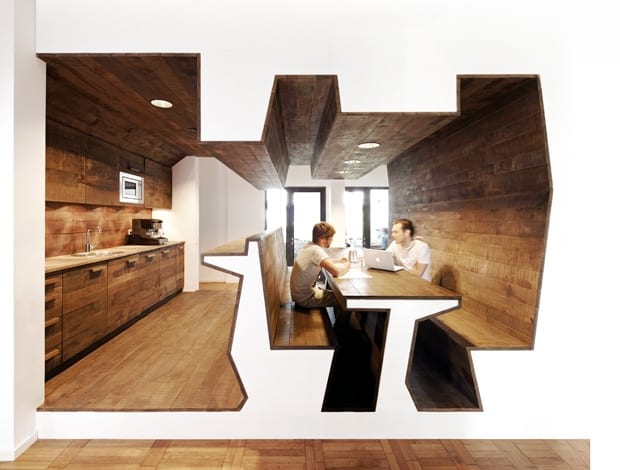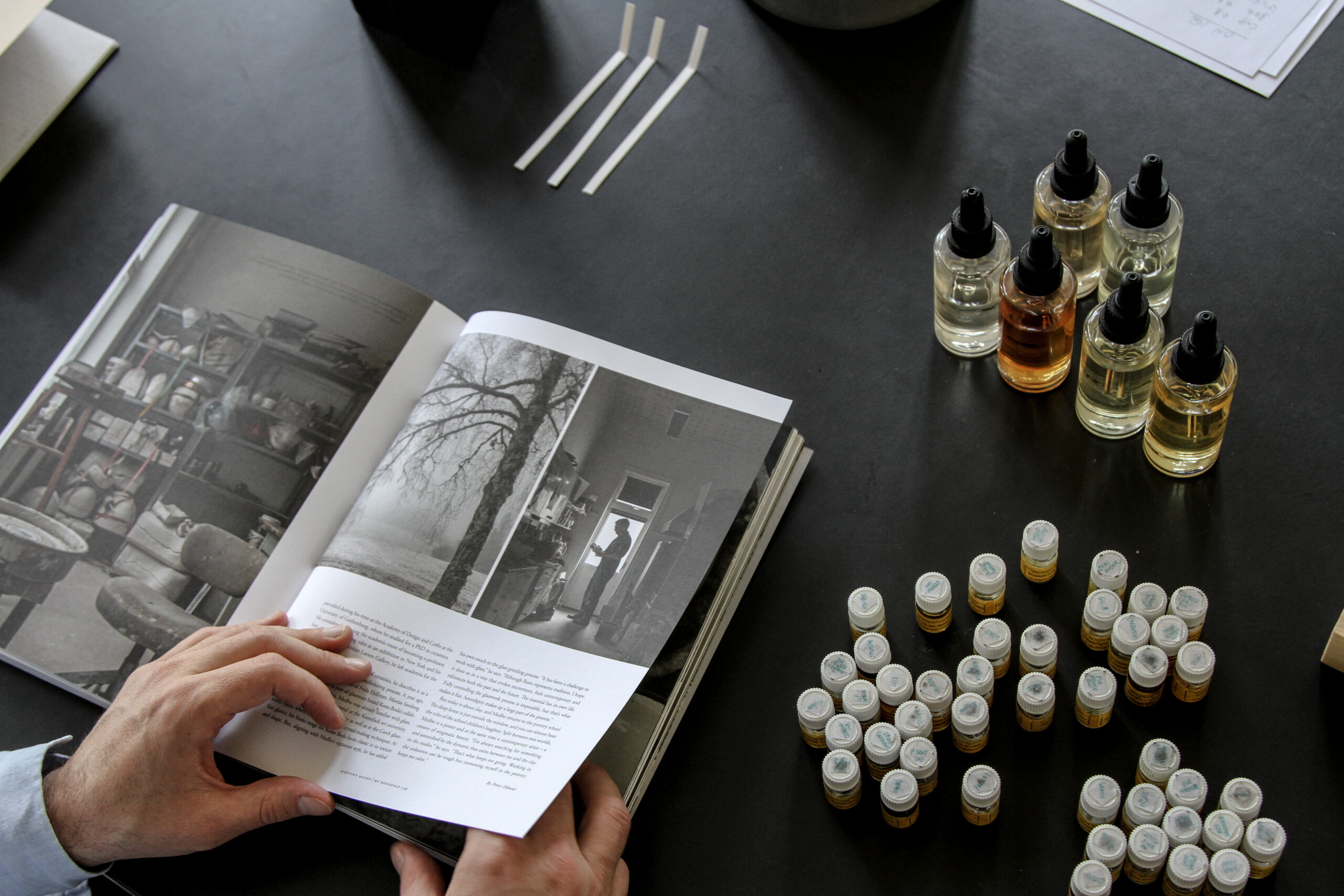 JVM’s Trojan Horse logo inspired its seating area: staff sit inside the “carcass”|A further Trojan Horse-inspired meeting area sits on the floor|The directors are “caged” in one room, visible through large steel louvers|A wooden hatch, built into the wall of the finance director’s office|Wooden planks can be stacked up to screen off the PA’s offices||
JVM’s Trojan Horse logo inspired its seating area: staff sit inside the “carcass”|A further Trojan Horse-inspired meeting area sits on the floor|The directors are “caged” in one room, visible through large steel louvers|A wooden hatch, built into the wall of the finance director’s office|Wooden planks can be stacked up to screen off the PA’s offices||
Every good design has a strong story behind it. Tapping into the area’s local history or referencing the company’s heritage are tried and tested ways of creating something meaningful. If there’s no story, it’s hard for architects to invent one.
But when your client happens to be Jung von Matt, Germany’s best-known advertising agency, a shortage of creative raw material is never going to be a problem. Like all successful advertisers, JVM specialises in creating myths and narratives to hawk their clients’ wares. When it came to perpetuating its own legend, the agency turned to Hamburg-based architects Stephen Williams Associates. The two firms had crossed paths eight years earlier when Williams had become friends with JVM’s finance director Ulli Palast. It was Palast, rather than the agency’s creative team, who approached Williams, thus kicking things off on a pragmatic rather than aesthetic footing. “We started off talking about function,” says Williams. “It was a question of ‘how do we get the best working spaces for their people so that they are as creative as possible?’”
The people in question were the finance department and JVM’s board of directors, which had usurped two floors of a converted warehouse the company already partially occupied. JVM’s primary concern was straightforward: the office should work properly. A funky, but flawed, fit-out by a younger architect had left the agency searching for a safe pair of hands. Thankfully, safe in this case does not mean dull and Williams’ design is packed full of interesting iconography and humour.
JVM is one of those rare beasts, an advertising company whose founding members are still on the board. Founded more than 20 years ago by Jean-Remy von Matt, the agency is now one of the most successful in Europe. With success came expansion and the original directors found themselves spread across multiple floors. Perhaps aware they were leaving their start-up roots behind, the bigwigs decided to work alongside each other around a 9m-long lozenge-shaped table. “The essence of the company is the interaction between these directors so instead of having a corner office and a little conference room they said ‘let’s go back and feel like we have started again,’” says Williams. The room dominates the floor, stretching nearly two-thirds across the floorplate and conflates symbolism with pragmatics. Workers passing by on the woven runner glimpse the directors at work courtesy of a series of steel louvers that work like a kind of slow-motion zoetrope. “There is transparency, but you can only see in if you stop and turn 90 degrees, which is kind of embarrassing,” says Williams.
The boardroom is dubbed the Elephant House – Germans call company directors elephants – and Williams eagerly played on its resemblance to a cage, saying that the louvers “bring in this toughness, like a kind of zoo.” The enormous desk is supported by thickset steel (elephant’s) legs, which had to be welded on site due to their size. Williams experimented lewdly with the vaginal shape of the table by housing the cabling in a rubber slot in its centre. Anyone wanting to fiddle with the wires has
to plunge in up to the elbow. The male members of the board reportedly love it.
On the financial floor below, things are less perverse. Surprisingly for a creative company, the layout favours cellular rather than open-plan workspace. Two-person offices line the perimeter length of the oblong floorplate. In the centre things get interesting with an unconventional breakout-cum-meeting-space constructed from whitewashed wooden floorboards. The concept is a bastardisation of the myth of the Trojan Horse, JVM’s symbol. The agency’s creatives steal themselves away inside, only to leap out armed with blow-your-mind concepts when its competitors are asleep. Williams rightly ate this idea up, creating what he calls a “conspiratorial, collaborative workshop”, the rough-hewn boards mimicking the wooden horse of yore. The practice even threw in a dog kennel. By using muted green for the walls and lowering the ceiling about the space, Williams enhanced the Machiavellian atmosphere. The concept is repeated in the kitchen area, where a chunk is cut from a wooden structure to form benches, a table and a breakfast bar. “We made the boards as dark as possible as this is supposed to be the carcass of the horse,” says Williams.
The characters that populate the office help to explain some of the office’s quirkier features. For instance, finance director Ulli Palast has a ranch-style wooden hatch opening into his office through which he is handed documents, and a desk customised so you can either sit and work or stand and chat. In the smaller meeting rooms the tables are standing only, which shows JVM has little time for gassing, if nothing else. Other vagaries include the wooden planks that can board up the glazed partitions in the PA offices.
But beneath all this is a fit-out of great integrity. Not wanting to betray the building’s origins as a workshop, the architect persuaded his client to hang onto the original wooden floor. Similarly, the steel window frames and table legs will rust over time in a further nod to its heritage. Williams’ ideas found fertile ground with Jean-Remy von Matt, with whom he met up every two weeks. Pitching concepts to a kingpin of Germany’s creative landscape was no cakewalk, however. “There are these silences while he is thinking about your ideas and you start to get a bit nervous. But no, he was really lovely to work with.”























